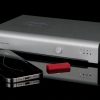BUYING A DIGITAL TELEVISION
Digital Television (DTV) is an entirely new technology that will ultimately replace today's analog television system. Digital signals are transmitted using computer code '" ones and zeroes – which means they are less susceptible to interference and provide a higher quality picture and sound than analog.
High-definition TV (HDTV) is the best quality DTV.
HDTV's sound and picture quality are many times better than today's analog TV. DTV also can be standard definition (SD) [good] or enhanced definition (ED) [better].
What you need to watch DTV:
DTV (including HDTV) is available over-the-air using a standard antenna or via digital cable or satellite. No matter how you receive your TV signal (cable, satellite or over-the-air), you will need DTV equipment to watch the DTV programming.
DTV equipment may be purchased as an all-in-one or component solution.
"Integrated" DTV sets with built-in tuners are an all-in-one solution for DTV '" they include a digital tuner to receive over-the-air DTV broadcasts and a monitor to display the programming.
A "component" solution includes a DTV monitor (screen) without a DTV tuner (these monitors are sometimes labeled "HD Ready"). Monitors must be paired with a cable or satellite set-top box, or stand-alone DTV tuner. "Digital cable ready" (or "plug-and-play") televisions are also available that can be used to receive digital cable TV without a separate set-top box. A CableCARD that can be plugged into the set is needed for certain cable programming.
Analog TVs will need additional equipment to receive over-the-air television when the DTV transition ends.
Today most people have analog televisions. All broadcast TV stations in the country have temporary use of a second, separate channel so that they can transition from analog broadcasting to digital. The target deadline for ending analog broadcasting is December 31, 2006, but this date may be extended. When analog broadcasting ends, consumers with analog sets will need to obtain a separate converter box to watch over-the-air TV. Analog sets equipped with a converter box will display the digital broadcasts, but not in full digital quality.
Definitions
Analog TV: Today's TV system using radio frequency waves to transmit and display pictures and sound.
Digital TV (DTV): Television delivered and displayed using radio frequency waves that contain information that is digitally encoded for improved quality and efficiency.
Standard Definition TV (SDTV): Basic digital television transmission that may be displayed with fewer than 480 progressively scanned lines (480p) in 16 x 9 or 4 x 3 format. 480 interlaced (480i) is the quality of today's analog TV system. SDTV provides 150-300,000 pixels.
Enhanced Definition TV (EDTV): A Better digital television transmission than SDTV with at least 480p, in a 16 x 9 or 4 x 3 display and Dolby digital surround sound. 480p is the quality used by most DVD players. EDTV provides 300-400,000 pixels.
High-Definition Television (HDTV): The best quality digital picture, widescreen (16 x 9) display with at least 720 progressively scanned lines (720p) or 1080 interlaced lines (1080i) and Dolby digital surround sound. HDTV provides 900,000-2.1 million pixels.
HDTV Monitor (sometimes called HDTV Ready): A set that can display HDTV programming if you have a separate HDTV tuner, HD Cable Set-Top Box or HD Satellite Set-Top-Box Receiver.
HDTV Tuner (also decoder, receiver, set-top box): A device capable of receiving and outputting HDTV signals for display. May be stand-alone or integrated in the set.
Integrated HDTV: An HDTV that has the digital tuner built into the set. It does not need a separate set-top box to receive over-the-air DTV signals.
Plug-and-Play or Digital Cable Ready: A DTV or other device for digital cable customers that plugs directly into the cable jack and does not require a separate set-top box. Plug and Play TV owners must obtain a CableCARD from their cable company in order to view scrambled programming services.
Interlace Scan: A way to scan vertical lines onto a TV picture by scanning all the odd lines first, then filling in the even lines (this happens instantaneously).
Progressive Scan: A way to scan vertical lines onto a TV picture by scanning all the lines consecutively (progressively).
Aspect ratio:
4 X 3: Traditional TV "aspect ratio," that is, the screen's width as compared to its height. For example, a "32 inch TV screen" would be 25 A½ inches wide and 19 inches tall.
16 X 9: "Widescreen" TV "aspect ratio" that is more like a movie screen than a traditional TV. For example, a "32 inch TV screen" would be 28 inches wide and 16 inches tall.
This is basic information about DTV to assist consumers; it is not an endorsement of any product, service or company by the FCC.
Printer Friendly Adobe PDF Version





























